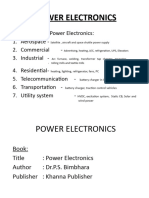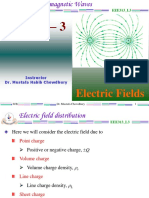EEE332 - Lecture 1
EEE332 - Lecture 1
Uploaded by
NASIM eeeCopyright:
Available Formats
EEE332 - Lecture 1
EEE332 - Lecture 1
Uploaded by
NASIM eeeOriginal Title
Copyright
Available Formats
Share this document
Did you find this document useful?
Is this content inappropriate?
Copyright:
Available Formats
EEE332 - Lecture 1
EEE332 - Lecture 1
Uploaded by
NASIM eeeCopyright:
Available Formats
EEE 332 / 413 (POWER ELECTRONICS AND DRIVES)
Lesson Outcomes
Lecture – 1
After completing this lecture, students will be able to
gain knowledge on definition, applications & history of
Introduction to
power electronics
explain power semiconductor devices and their
Power Electronics
switching characteristic
explain power converter types
Prof. Abdur Razzak EEE 332/413 Lecture 1 Page 1/14
What is power electronics?
Power electronics is defined as the applications of solid state electronics for the control
and conversion of electric power.
Power electronics circuits manage the flow of electrical energy between some sort of
source and a load. These circuits handle power flow at levels much higher than the
individual device ratings.
A basic power electronic system
Prof. Abdur Razzak EEE 332/413 Lecture 1 Page 2/14
Power converters
AC-DC converters (diode rectifiers & controlled rectifiers)
AC-AC converters (ac voltage controllers)
DC-DC converters (dc choppers) DC-DC converter
DC-AC converters (inverters)
AC-DC converter AC-AC converter DC-AC converter
Prof. Abdur Razzak EEE 332/413 Lecture 1 Page 3/14
History of power electronics
1900 – Mercury arc rectifier
1948 – Silicon transistor
1956 – Thyristor /
Silicon controlled rectifier (SCR)
1958 – Commercial thyristor
1980 -1990 – Modern power electronics
Prof. Abdur Razzak EEE 332/413 Lecture 1 Page 4/14
Applications
Aircraft power supplies RF amplifiers
Electric vehicles Servo systems
Electronic ignition Solar power supplies
High frequency lighting Static relays
High voltage dc (HVDC) Temperature control
Induction heating Traffic signal control
Electronic ballast Uninterruptible power
supply (UPS)
Linear induction motor control
VAR compensation
Nuclear reactor control rods
Voltage regulator
Radar power supplies
Prof. Abdur Razzak EEE 332/413 Lecture 1 Page 5/14
Classification of power semiconductor devices
Diodes
Schottky diode, PIN diode, Gun diode
Transistors
BJT, MOSFET, IGBT, SIT
Thyristors (SCR)
GTO, SITH, MCT, MTO
Prof. Abdur Razzak EEE 332/413 Lecture 1 Page 6/14
Classification of power semiconductor devices
Name V-I ratings Speed Operation Use
Diode 1 – >5000 A <20 ns – 100 ms conduct when anode voltage is rectifiers, dc-dc circuits
10V–10 kV more positive than cathode
BJT 0.5–500 A 0.5 – 100 ms conducts when sufficient base dc-dc circuits, inverters
30–1200 V current is applied
FET 1–100 A 50 – 200 ns conducts when sufficient gate dc-dc circuits, inverters
30–1000V voltage is applied
IGBT 10– > 600 A Faster than BJT similar to BJT with its base power electronics
600–1700 V driven by a FET
SCR 10– > 500 A 1 – 200 ms like a diode after a gate pulse controlled rectifiers
200V–5 kV is applied
GTO similar to SCR similar to SCR conducts with a negative pulse inverters >100 kW
to its gate terminal
TRIAC 2–50 A similar to SCR two SCRs connected in lamp dimmers
200–800 V reverse parallel
Prof. Abdur Razzak EEE 332/413 Lecture 1 Page 7/14
Switching characteristics of IGBT
Prof. Abdur Razzak EEE 332/413 Lecture 1 Page 8/14
Switching characteristics of MOSFET
Prof. Abdur Razzak EEE 332/413 Lecture 1 Page 9/14
Switching characteristics of Thyristor
Prof. Abdur Razzak EEE 332/413 Lecture 1 Page 10/14
Choice of power semiconductor devices
The choice of a
particular device
depends on the
voltage, current,
and speed
requirements of
the converter.
Prof. Abdur Razzak EEE 332/413 Lecture 1 Page 11/14
References
1. M. H. Rashid, Power Electronics – Circuits, Devices & Applications, 3rd Ed,
Pearson, pp. 1–30.
2. Power Electronics Handbook, M. H. Rashid (Editor-in-Chief), Academic Press,
pp. 1–12.
Prof. Abdur Razzak EEE 332/413 Lecture 1 Page 12/14
Any questions, comments?
Prof. Abdur Razzak EEE 332/413 Lecture 1 Page 13/14
Next lecture!
Generalized
Power Converters
Prof. Abdur Razzak EEE 332/413 Lecture 1 Page 14/14
You might also like
- Worksheets and Handouts ACTDailyJournalDocument3 pagesWorksheets and Handouts ACTDailyJournalLarry GauthierNo ratings yet
- Trilogy of Wireless Power: Basic principles, WPT Systems and ApplicationsFrom EverandTrilogy of Wireless Power: Basic principles, WPT Systems and ApplicationsNo ratings yet
- Power Semiconductor DevicesDocument34 pagesPower Semiconductor Devicesgate steinsNo ratings yet
- Unit-1 Introduction: 1.0 Introduction To Power ElectronicsDocument30 pagesUnit-1 Introduction: 1.0 Introduction To Power ElectronicsAishwarya PKamatagiNo ratings yet
- Unit IDocument23 pagesUnit IAnkit GuhaNo ratings yet
- Module 1Document30 pagesModule 1Sathya Prakash PNo ratings yet
- ECCE4467/MCTE 4210 Power Electronics and DrivesDocument82 pagesECCE4467/MCTE 4210 Power Electronics and DrivesibrahimNo ratings yet
- EE 312 PE Lec 1 IntroDocument14 pagesEE 312 PE Lec 1 IntroSyed KumailNo ratings yet
- Power Electronics M3 LESSON NOTES ALL TopicsDocument126 pagesPower Electronics M3 LESSON NOTES ALL Topicsjmutugi851No ratings yet
- FEE 541 Power Electronics and VFDsDocument3 pagesFEE 541 Power Electronics and VFDsOpapa PeterNo ratings yet
- Ee121 Lec1 - AnnotatedDocument26 pagesEe121 Lec1 - AnnotatedreneSantosIVNo ratings yet
- Series and Parallel OperationDocument106 pagesSeries and Parallel Operationoctober87No ratings yet
- Lecture 1Document69 pagesLecture 1kaybeall7584No ratings yet
- 225 230, Tesma410, IJEASTDocument6 pages225 230, Tesma410, IJEASTAkram KareemNo ratings yet
- P.E.S. College of Engineering, Aurangabad.: Project ReportDocument25 pagesP.E.S. College of Engineering, Aurangabad.: Project ReportShaikh Ibrahim0% (1)
- Power Electronics NotesDocument44 pagesPower Electronics Notessameekshaa75% (4)
- Power Electronics and Drives 1718791327Document141 pagesPower Electronics and Drives 1718791327jkj9t78924No ratings yet
- Unit I Power Semi-Conductor Devices: Topic Sub TopicsDocument52 pagesUnit I Power Semi-Conductor Devices: Topic Sub TopicsNarasimman DonNo ratings yet
- Ee8552-Power Electronics Collection - by Learnengineering - inDocument93 pagesEe8552-Power Electronics Collection - by Learnengineering - inTomNo ratings yet
- Introduction Unit1Document34 pagesIntroduction Unit1senthilku marNo ratings yet
- Eee 3322 Power ElectronicsDocument30 pagesEee 3322 Power Electronicsgate steinsNo ratings yet
- ECCE4467/MCTE 4210 Power Electronics and DrivesDocument47 pagesECCE4467/MCTE 4210 Power Electronics and DrivesibrahimNo ratings yet
- Pe - Lecture - Notes PDFDocument178 pagesPe - Lecture - Notes PDFSaurabh SinghNo ratings yet
- G. Pulla Reddy Engineering College (Autonomous) : Kurnool Department of Electrical & Electronics Engineering Power Electronics (PEP) Laboratory (Scheme-2013)Document87 pagesG. Pulla Reddy Engineering College (Autonomous) : Kurnool Department of Electrical & Electronics Engineering Power Electronics (PEP) Laboratory (Scheme-2013)Sreenath SreenathNo ratings yet
- Power Electronics: Unit 1 Thyristor Characteristics and PrinciplesDocument30 pagesPower Electronics: Unit 1 Thyristor Characteristics and PrinciplesMudit PrabhakarNo ratings yet
- Power Electronics Notes For Diploma in Electrical and Electronics Engineering Module 3 - 100717Document63 pagesPower Electronics Notes For Diploma in Electrical and Electronics Engineering Module 3 - 100717phenyawuor2000No ratings yet
- Pe IntroductionDocument31 pagesPe IntroductionJunaxic MuxicNo ratings yet
- Design Fabrication and Performance Analysis of Solar InverterDocument5 pagesDesign Fabrication and Performance Analysis of Solar InverterSyed ZadaaNo ratings yet
- Gunrock Final TodayDocument57 pagesGunrock Final Today035 Shiva TejaNo ratings yet
- Introduction To Automotive Electrical and Electronic SystemsDocument32 pagesIntroduction To Automotive Electrical and Electronic SystemsBảo AnNo ratings yet
- Mini Project 002Document54 pagesMini Project 002Sumit ShishodiaNo ratings yet
- Pe Whole PDFDocument165 pagesPe Whole PDFHarshithaPuretiNo ratings yet
- Irjet V7i3986Document5 pagesIrjet V7i3986Vasu ThakurNo ratings yet
- Power ElectronicsDocument264 pagesPower ElectronicsJayashree C RaoNo ratings yet
- Design of Buck DC-DC Converter Space ApplicationDocument7 pagesDesign of Buck DC-DC Converter Space ApplicationIJRASETPublicationsNo ratings yet
- Electrical Notes For VIVA VOCEDocument5 pagesElectrical Notes For VIVA VOCE8ke0472xre4lzzw72r8No ratings yet
- Power Electronics Lab ManualDocument44 pagesPower Electronics Lab Manualshilpi sahaNo ratings yet
- Line Notching Attenuation: Application NotesDocument2 pagesLine Notching Attenuation: Application NotesNuc LeusNo ratings yet
- Annamacharya Institute of Technology and Sciences, Tirupati. Department of Electrical &electronic EngineeringDocument37 pagesAnnamacharya Institute of Technology and Sciences, Tirupati. Department of Electrical &electronic EngineeringSenthil KumarNo ratings yet
- Power Electronics EngineeringDocument30 pagesPower Electronics Engineeringiamjarvis990No ratings yet
- For Training - June 2015Document59 pagesFor Training - June 2015Lionel MessiNo ratings yet
- Apparatus Module 3Document99 pagesApparatus Module 3Danzel SepilloNo ratings yet
- Name of Electrical Symbols PDFDocument6 pagesName of Electrical Symbols PDFHarsh MittalNo ratings yet
- ECTE324/8324: Power Engineering 1 Week 9: Lecture 9: Introduction To Power ElectronicsDocument35 pagesECTE324/8324: Power Engineering 1 Week 9: Lecture 9: Introduction To Power ElectronicsPrashant KunaNo ratings yet
- Fundamentals of Power ElectronicsDocument12 pagesFundamentals of Power ElectronicsYT ZhouNo ratings yet
- Unit 1Document73 pagesUnit 1bxr4fvwjhvNo ratings yet
- Designandconstructionofa1 5kvainverterusing12vbatteriesMODIFIEDfinal16022016Document13 pagesDesignandconstructionofa1 5kvainverterusing12vbatteriesMODIFIEDfinal16022016shah pallav pankaj kumarNo ratings yet
- Sinha Power Plant QuestionDocument14 pagesSinha Power Plant QuestionRaihanNo ratings yet
- Analog Electronic (BEL 10203) : Faculty of Electrical & Electronic Engineering, UTHMDocument29 pagesAnalog Electronic (BEL 10203) : Faculty of Electrical & Electronic Engineering, UTHMRicky PaltaNo ratings yet
- 1 Power Electronics - IntroductionDocument10 pages1 Power Electronics - Introductionggomathi2004No ratings yet
- Power Semiconductor DevicesDocument26 pagesPower Semiconductor DeviceskumareshNo ratings yet
- Introduction To Power Electronics, History & Applications (1), Semiconductor Devices EtcDocument73 pagesIntroduction To Power Electronics, History & Applications (1), Semiconductor Devices Etckomal phulpotoNo ratings yet
- Power Electronics - Quick GuideDocument53 pagesPower Electronics - Quick Guideblessedgeraldie78No ratings yet
- Simulation of Power Electronic Converters Using Matlab SimulinkDocument19 pagesSimulation of Power Electronic Converters Using Matlab SimulinkajithNo ratings yet
- Xlecture 1 - Introduction To Power ElectronicsDocument17 pagesXlecture 1 - Introduction To Power ElectronicsমোঃওমরফারুকNo ratings yet
- DEMODocument2 pagesDEMOShaik Abdul RaqeebNo ratings yet
- David Perreault Slide PresentationDocument40 pagesDavid Perreault Slide PresentationMax Li100% (1)
- Power Electronics 2010-2011Document68 pagesPower Electronics 2010-2011Adnan Younus100% (1)
- Power Electronics and Energy Conversion Systems, Fundamentals and Hard-switching ConvertersFrom EverandPower Electronics and Energy Conversion Systems, Fundamentals and Hard-switching ConvertersNo ratings yet
- It Is Quite Another Electricity: Transmitting by One Wire and Without GroundingFrom EverandIt Is Quite Another Electricity: Transmitting by One Wire and Without GroundingNo ratings yet
- Department of Electrical and Electronic Engineering Course OutlineDocument6 pagesDepartment of Electrical and Electronic Engineering Course OutlineNASIM eeeNo ratings yet
- Mc-Eee313 L2Document19 pagesMc-Eee313 L2NASIM eeeNo ratings yet
- Lecture - 1: Faculty Dr. Mustafa Habib ChowdhuryDocument11 pagesLecture - 1: Faculty Dr. Mustafa Habib ChowdhuryNASIM eeeNo ratings yet
- Mc-Eee313 L3Document17 pagesMc-Eee313 L3NASIM eeeNo ratings yet
- Welcome: Basic Concepts Related To NetworkDocument30 pagesWelcome: Basic Concepts Related To NetworkNASIM eeeNo ratings yet
- Chapter04-2 Multiple Access Reference Haykin Chapter 8Document25 pagesChapter04-2 Multiple Access Reference Haykin Chapter 8NASIM eeeNo ratings yet
- Welcome: To Telecom NetworksDocument20 pagesWelcome: To Telecom NetworksNASIM eeeNo ratings yet
- Chapter04-1 Multiplexing Reference Forouzan Chapter 6Document50 pagesChapter04-1 Multiplexing Reference Forouzan Chapter 6NASIM eeeNo ratings yet
- Organizational Justice The Sound Investment in OrganizationsDocument9 pagesOrganizational Justice The Sound Investment in OrganizationsMohammad Sohail RashidNo ratings yet
- Special Relativity in Week One 1) The Principle of RelativityDocument5 pagesSpecial Relativity in Week One 1) The Principle of RelativityeltyphysicsNo ratings yet
- 022 - Leadership ChallengesDocument7 pages022 - Leadership ChallengesTwelve Forty-fourNo ratings yet
- Bam 200 Sas #19Document7 pagesBam 200 Sas #19allia LopezNo ratings yet
- 06 Programmable Logic Controller PracticalDocument3 pages06 Programmable Logic Controller PracticalAnkitNo ratings yet
- Chap. 1 Seismic Design Specifications For Highway Bridges (2002) (By Japan Road Association)Document7 pagesChap. 1 Seismic Design Specifications For Highway Bridges (2002) (By Japan Road Association)NachoNo ratings yet
- IEC 62353 BookletDocument18 pagesIEC 62353 BookletArmanNo ratings yet
- SEAG Paper 01Document22 pagesSEAG Paper 01lovely.designs.pubNo ratings yet
- Conventional Encryption Message ConfidentialityDocument26 pagesConventional Encryption Message Confidentialityishita chakrabortyNo ratings yet
- Modular Switchgear in Pre-Fabricated Housing: Integrated GIS Technology Up To 420 KVDocument2 pagesModular Switchgear in Pre-Fabricated Housing: Integrated GIS Technology Up To 420 KVHan HuangNo ratings yet
- Hydrogen Peroxide Cyanide Destruction PlantDocument6 pagesHydrogen Peroxide Cyanide Destruction PlantPedro FigueiraNo ratings yet
- Ritararenga Antoinette - Lab2Document4 pagesRitararenga Antoinette - Lab2gatete samNo ratings yet
- Rajkot PGVCLDocument2 pagesRajkot PGVCLSolanki AshokNo ratings yet
- CAC F1 F2 Communication Check With A Multi-TesterDocument9 pagesCAC F1 F2 Communication Check With A Multi-Testersonic8659No ratings yet
- Educational SupervisionDocument9 pagesEducational SupervisionHapani HarunNo ratings yet
- Emily Shumway LetterDocument1 pageEmily Shumway Letterapi-451969806No ratings yet
- Technical Note 4Document3 pagesTechnical Note 4princedottyNo ratings yet
- NGP Arts Front PageDocument4 pagesNGP Arts Front Pagezxy_cbeNo ratings yet
- Hcna - HNTDDocument2 pagesHcna - HNTDmahemed mamounNo ratings yet
- Marine Mammal Stranding Response Manual 2nd EdDocument141 pagesMarine Mammal Stranding Response Manual 2nd EdLokal Lab OngroundNo ratings yet
- The Translation Process: A View of The Mind: Ali DarwishDocument4 pagesThe Translation Process: A View of The Mind: Ali DarwishhjgfjhNo ratings yet
- Postmodern Architecture in Thailand 1982-1997 KeyDocument21 pagesPostmodern Architecture in Thailand 1982-1997 KeyNga ĐặngNo ratings yet
- Session Guide TemplateDocument9 pagesSession Guide TemplateRodelMinianoNo ratings yet
- Liquidation ReportDocument3 pagesLiquidation Reportkabataansulong2023No ratings yet
- PES SlideshowDocument82 pagesPES SlideshowHunter 911No ratings yet
- Outline BECO1000Document6 pagesOutline BECO1000Fd AhNo ratings yet
- Mind Over Matter: Evidence That Consciousness Is Connected To, and Affects The Physical World Around UsDocument25 pagesMind Over Matter: Evidence That Consciousness Is Connected To, and Affects The Physical World Around UsKosta Kourabis100% (1)
- Lxmldoc-2 3Document439 pagesLxmldoc-2 3Angelo SilvaNo ratings yet
- CloudComputing Model Answer Key 2024Document1 pageCloudComputing Model Answer Key 2024venkatesh.mNo ratings yet

































































































